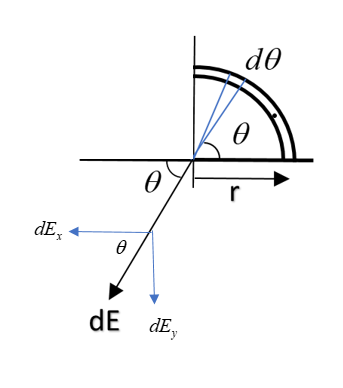Question
Question: Electric field at the centre of a quarter circular ring having charge density \(\lambda\) is: 
Solution
Here, it is important to note that the charge is distributed over an object. Hence we can’t directly apply Coulomb's law which is valid for point charge. Hence we need to get the electric field due to any general element and then integrate over the ring to get a net electric field at the centre.
Formula used:
dE=r2Kdq
Complete answer:
First of all, we have to consider an elementary part of the ring at an angle θ having angular length of dθ. The small charge inside the elementary part will be calculated as follows:
Charge density λ is defined as charge per unit length. Thus, the charge in the elementary part ‘Rdθ’ will be λRdθ.
Thus dq=λRdθ
Now, using dE=r2Kdq, we have
dE=R2KλRdθ=RKλdθ
Now, as the ring is unsymmetric, we have to find the field in both directions i.e. in x direction and in y direction separately.

So, field in x-direction: dEx=dEcosθ
dEx=RKλcosθdθ
Integrating, we get:
∫dEx=0∫π/2RKλcosθdθ
Ex=RKλ0∫π/2cosθdθ=RKλ(sin(2π)−sin0)=RKλ
Also, field in y-direction:
dEy=dEsinθ=RKλ×sinθdθ
Then, Ey=∫dEsinθ=∫RKλ×sinθdθ
Or, Ey=RKλ×0∫π/2sinθdθ [ as K. q and r are constants ]
Ey=RKλ×−(cos(π/2)−cos0)=RKλ
Now, the net field will be the vector sum of both x and y component:
Thus, Enet=Ex2+Ey2
Or Enet=(RKλ)2+(RKλ)2
⟹Enet=2RKλ
Note:
This type of question must be tackled only by taking a small element and writing electric fields for smaller elements. In some questions, the figure might be symmetric. In that case, we can directly write the component of the electric field which is symmetric as zero. Also students should understand how to take the limits. If the material were present in the first as well as second quadrant, we might have taken the limits from 0 to π instead of 0 to2π.
